|
|
 Mine Train through
Mine Train throughNature’s Wonderland |
||
|
|
|||
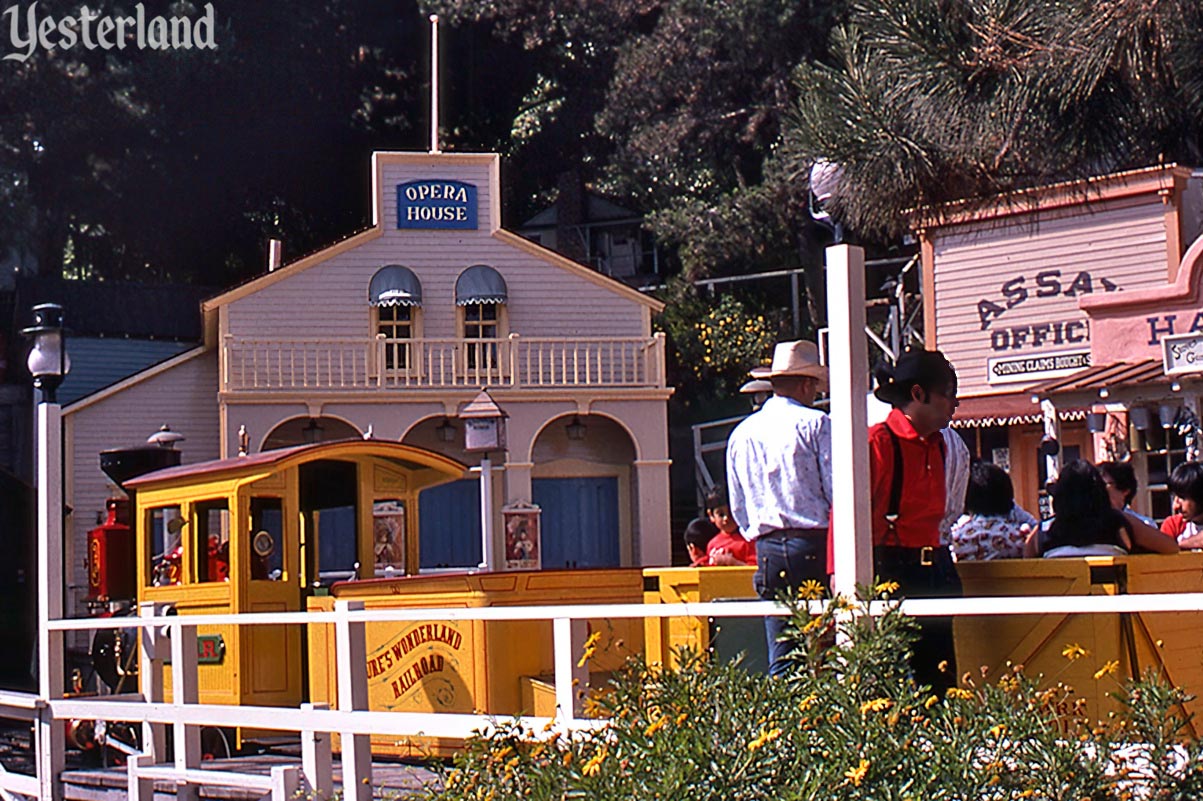
Photo by Werner Weiss, 1975 |
|||
|
Welcome to a great attraction in the tradition of the Jungle Cruise—only this time it’s the environment and animals of North American wilderness areas instead of those of the world’s jungles. |
|||
|
|
|||
|
The loading platform for the Mine Train Through Nature’s Wonderland is in the Western mining town of Rainbow Ridge. As you wait to board the train, listen to the sounds emanating from the buildings, such as the music from the Last Chance Saloon and the screams from the dentist’s office above it. |
|||
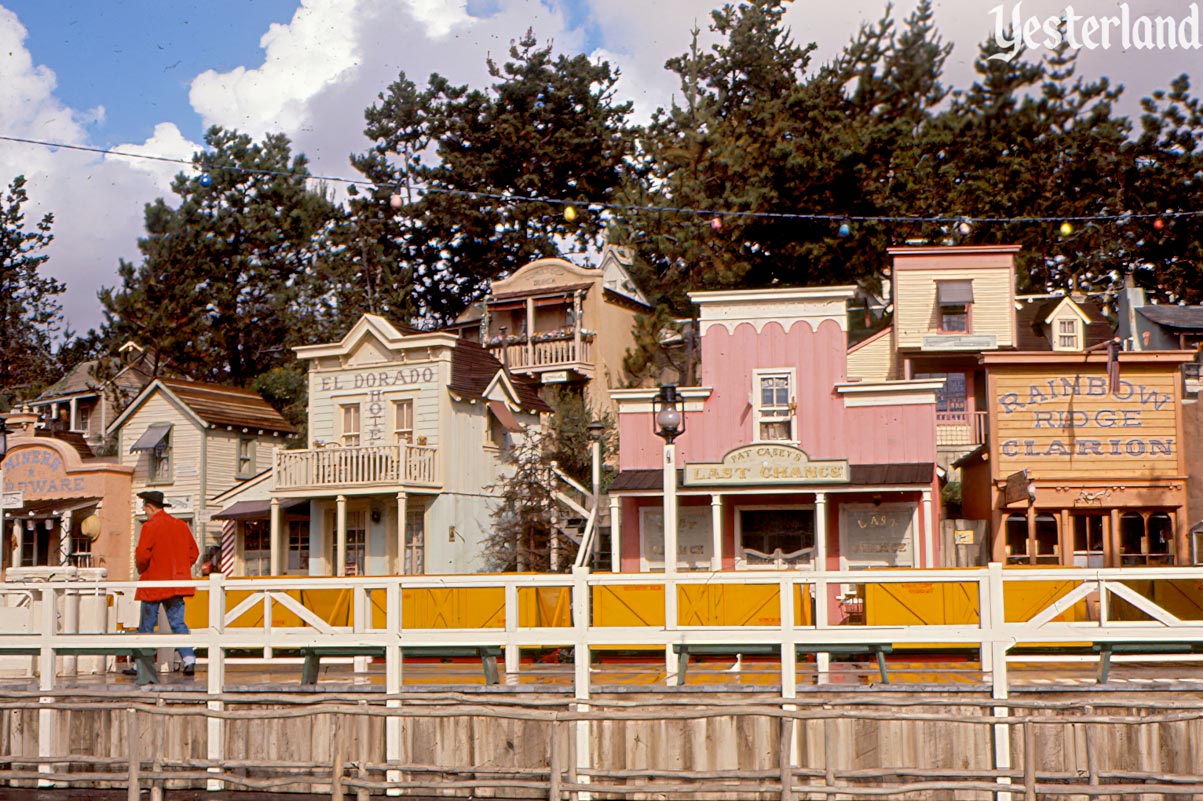
Photo by Roger J. Runck, 1961, courtesy of Robin Runck Rainbow Ridge |
|||
|
Inspired by Disney’s True-Life Adventure nature movies of the 1950s, Nature’s Wonderland is home to more than two-hundred lifelike, animated mammals, reptiles, and birds. As your train travels through Bear Country, Olympic Elk, Beaver Valley, the Living Desert, and Rainbow Caverns, you will see:
|
|||
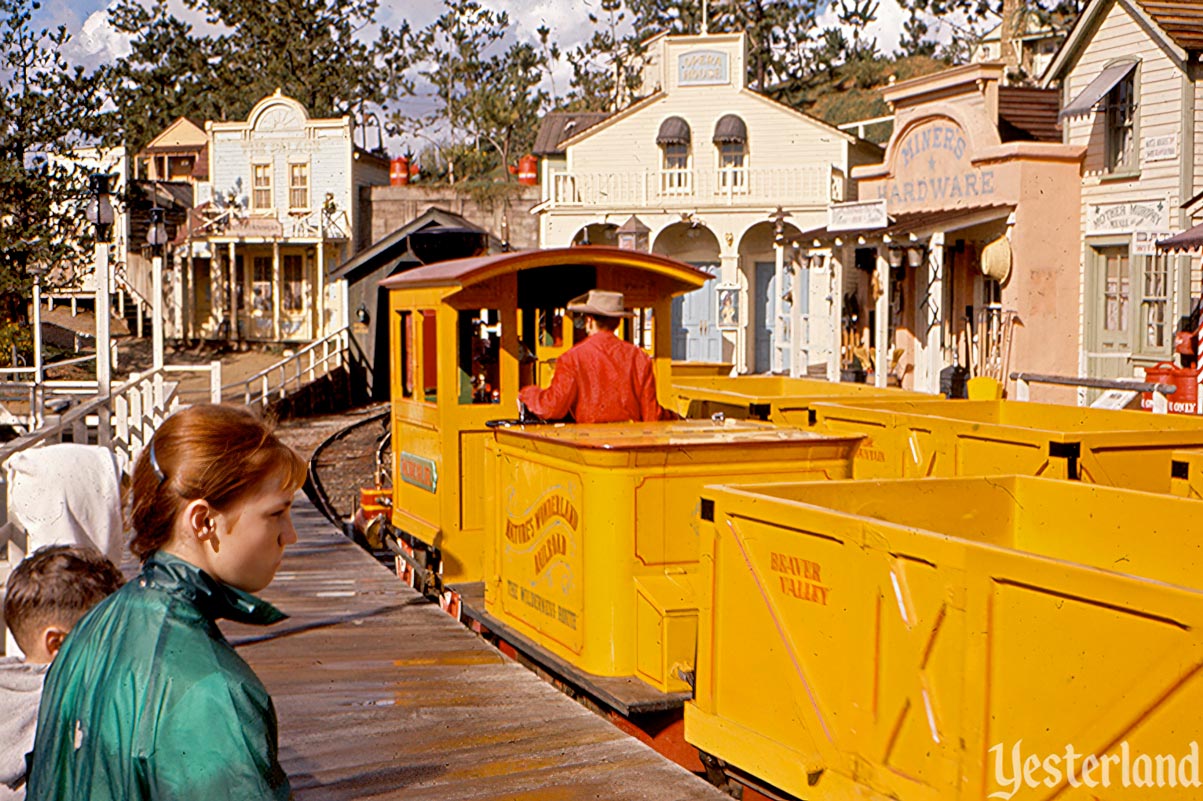
Photo by Roger J. Runck, 1961, courtesy of Robin Runck Platform |
|||
|
Take a seat on one of the benches facing each other in your bright yellow ore car. Or sit on the jump seat when the ride attendant closes the ore car door. When your train pulls out of the station, an old miner begins a recorded narration: “Howdy, folks! Welcome to the little minin’ town of Rainbow Ridge, the gateway to Nature’s Wonderland. As we head for the wilderness, a couple of suggestions: please stay seated at all times, and keep yer hands and arms inside the train. The animals get mighty hungry. And, uh, no smokin’ please, ’cause we don’t want to start a forest fire. Now, beyond these hills lies Nature’s Wonderland. Yer apt to see a whole lotta wildlife, so… keep a real sharp hunter’s eye. |
|||
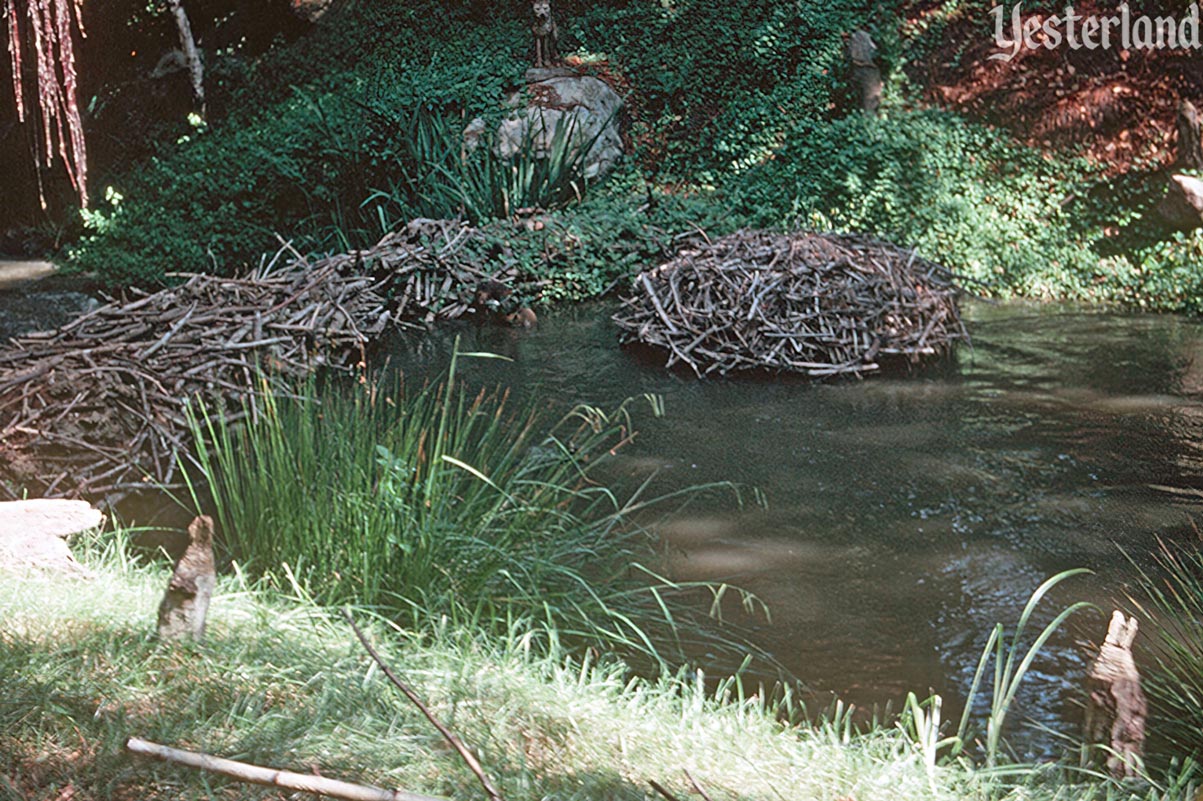
Photo by Marion Caswell, 1976, courtesy Dennis Caswell Beaver Valley |
|||
|
“As we come out of this first tunnel, we’ll be entering Beaver Valley. Looks like the beavers are building another dam. Yes, sir, they’re really busy as a… well, busy as a beaver. Them little marmots over the tunnel must be a-whistlin’ to all you pretty gals. I can’t say I blame ‘em. |
|||
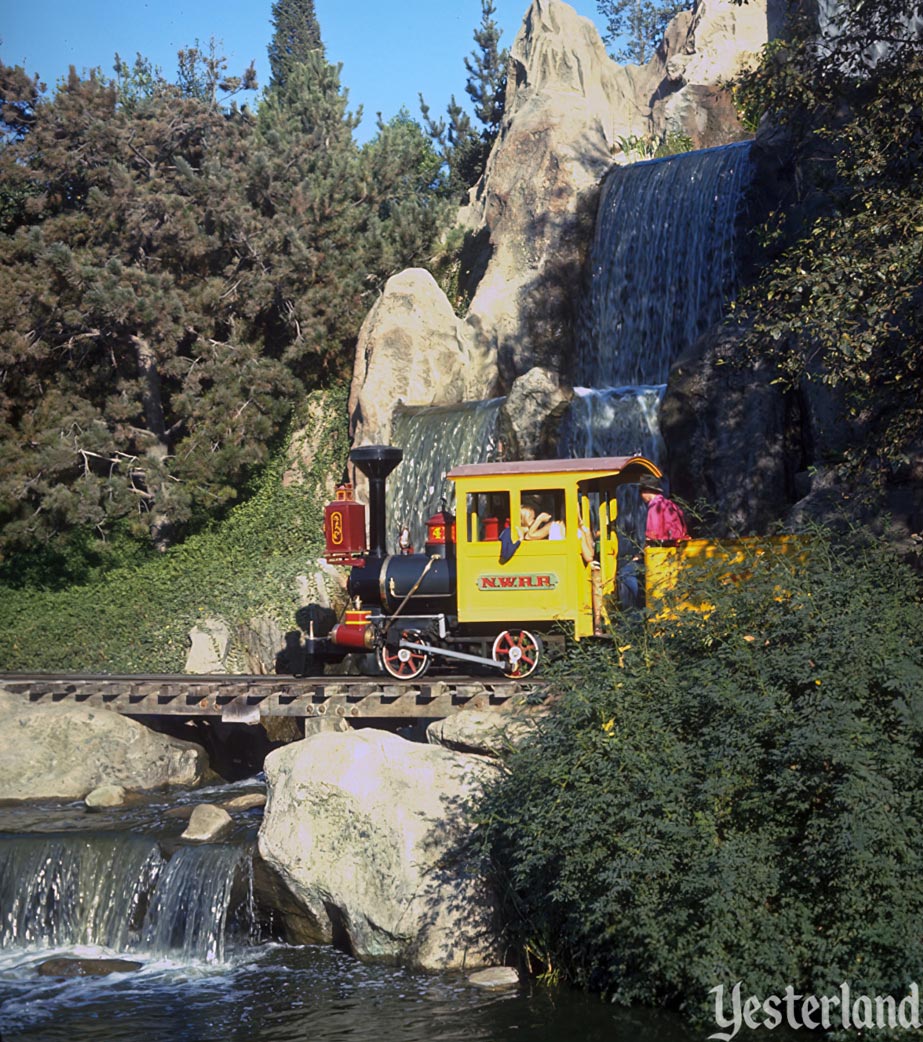
Photo by Werner Weiss, 1969 Cascade Peak |
|||
|
“If yuh’ve never gone beneath a waterfall before, then get set, cause we’re comin’ up on Big Thunder, the biggest falls in all these here parts. Yuh don’t hafta worry though… unless the wind changes. Them other two falls they call the Twin Sisters—reckon that’s cause they’re always babblin’. |
|||
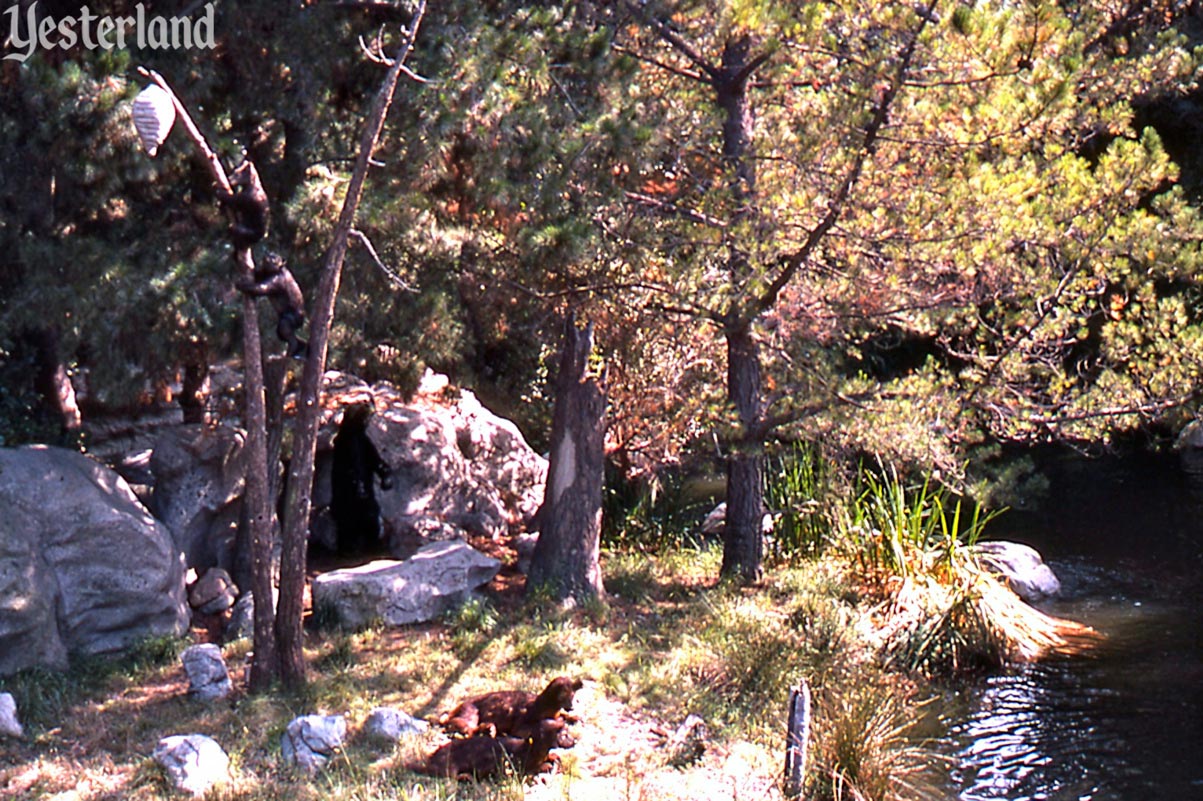
Photo by Werner Weiss, 1975 Bears in the trees and on the ground |
|||
|
“We’re comin’ into Bear Country now, folks, and, while we’re crossin’ the old trestle, ya gotta sit real still. No tellin’ how long she’s gonna last. |
|||
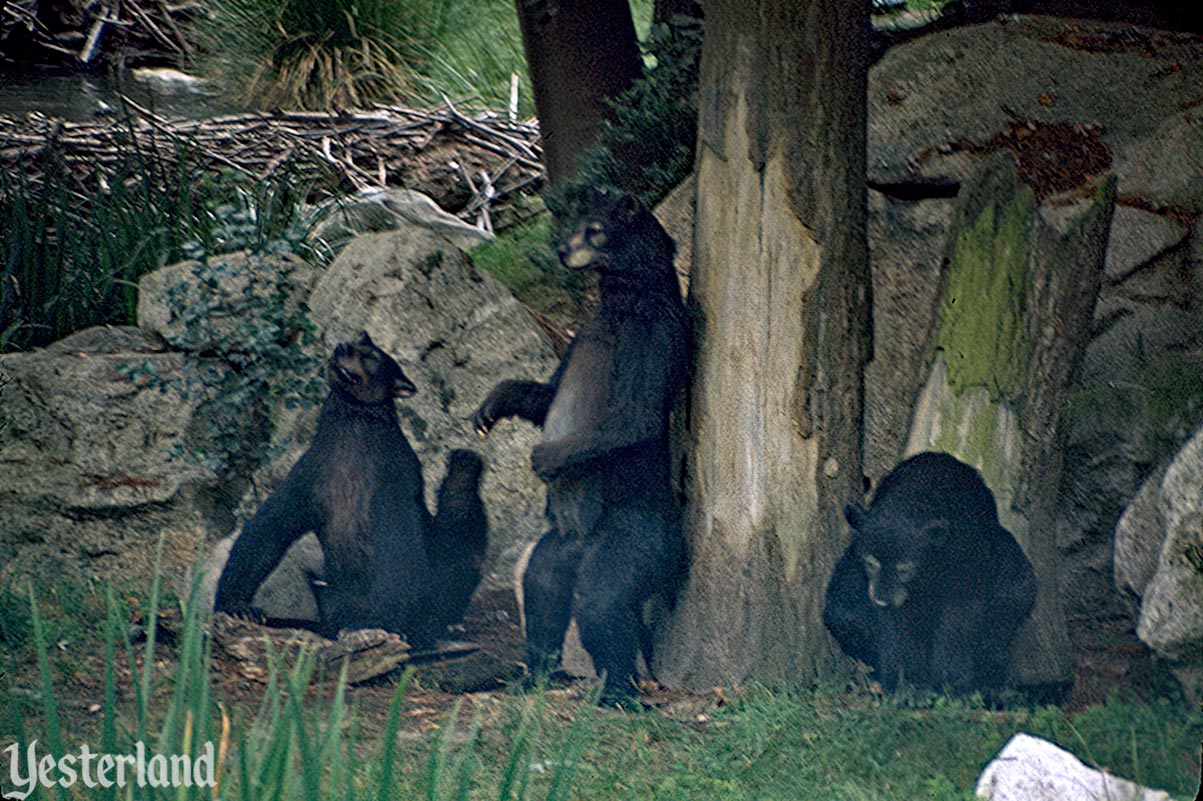
Photo by Dennis Caswell, 1975 Bear Country, not to be confused with Bear Country |
|||
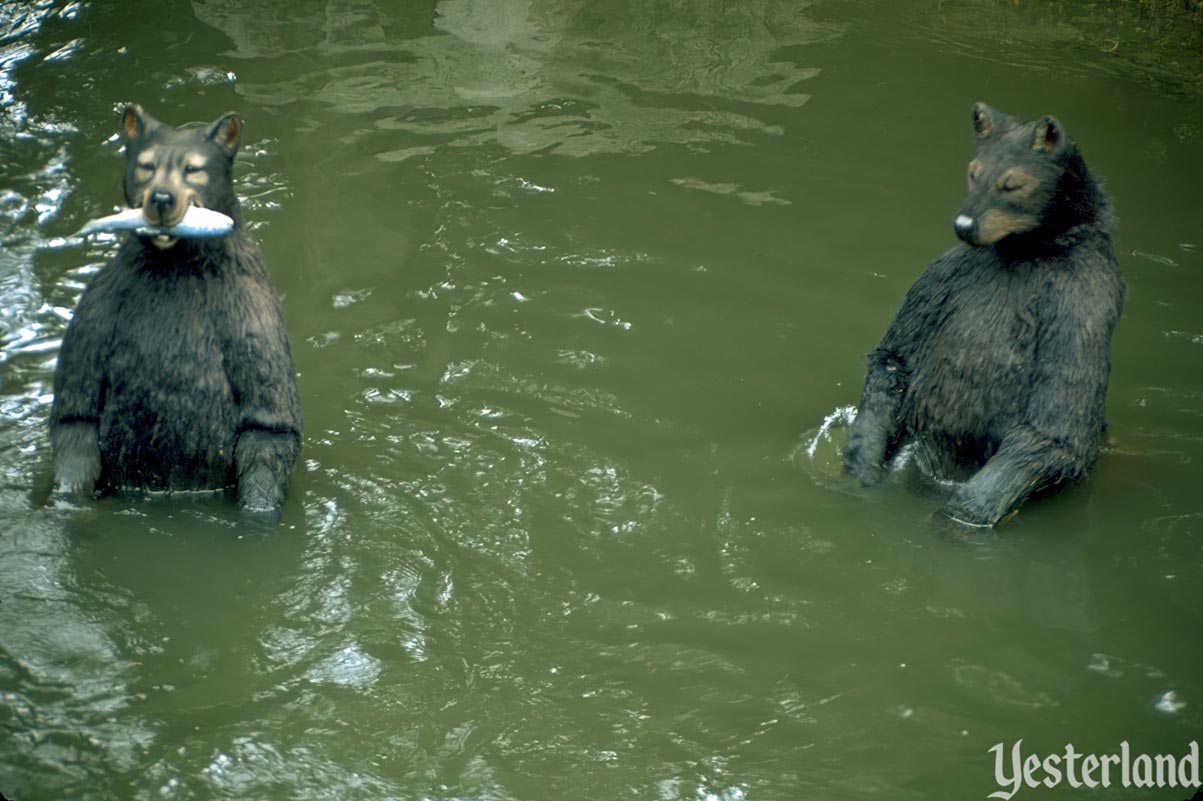
Photo by Dennis Caswell, 1975 Caught one! |
|||
|
“Ya know, bears are one of the most playful animals there is. Lazy, too. All they want to do is lay around and scratch and fish and swim… that is when they ain’t sleepin’. |
|||
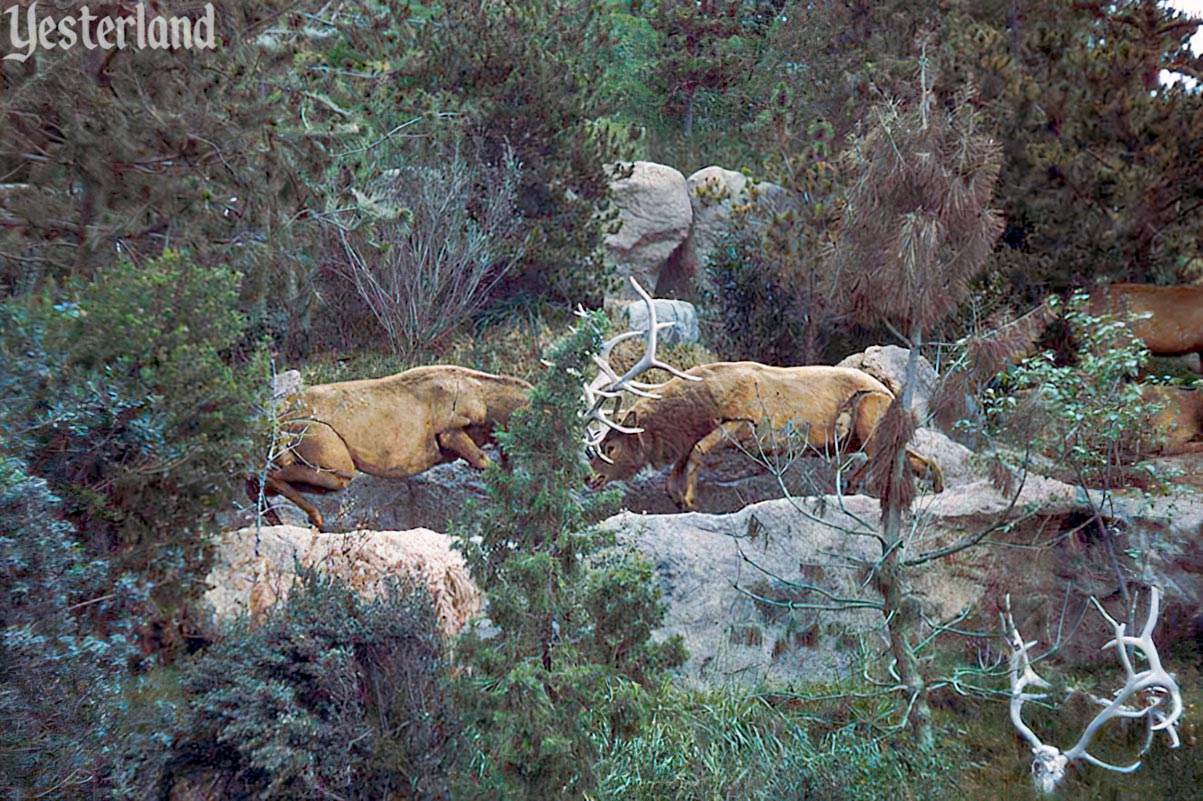
Photo by cpo57, (CC BY 2.0) (modified) Olympic Elk |
|||
|
“You know, Nature’s Wonderland is awful pretty, but sometimes she can be a mighty rugged place to live. Out here in the wilderness, the struggle for survival leaves only the strong and sometimes the lucky. Say, look on that bank, ‘cross Bear Creek, there. Now there’s a real struggle for survival. Two stags are battlin’ for them cow elk. Maybe you folks can tell me, though—does gettin’ two womenfolk mean you’re the winner or the loser? Never could figger that’n out. “As we pass through ol’ Natural Arch Bridge, ya can see the great Living Desert down below. Ya know, the desert’s a dry place, and full of some pretty mean varmints. Gotta be careful of sidewinders, wild pigs, and even mountain lions. But the desert’s got her beauty, too. The yeller streaks a-runnin’ through them sandstone cliffs are called ‘coconino.’ The red, we call them ‘supai.’ |
|||
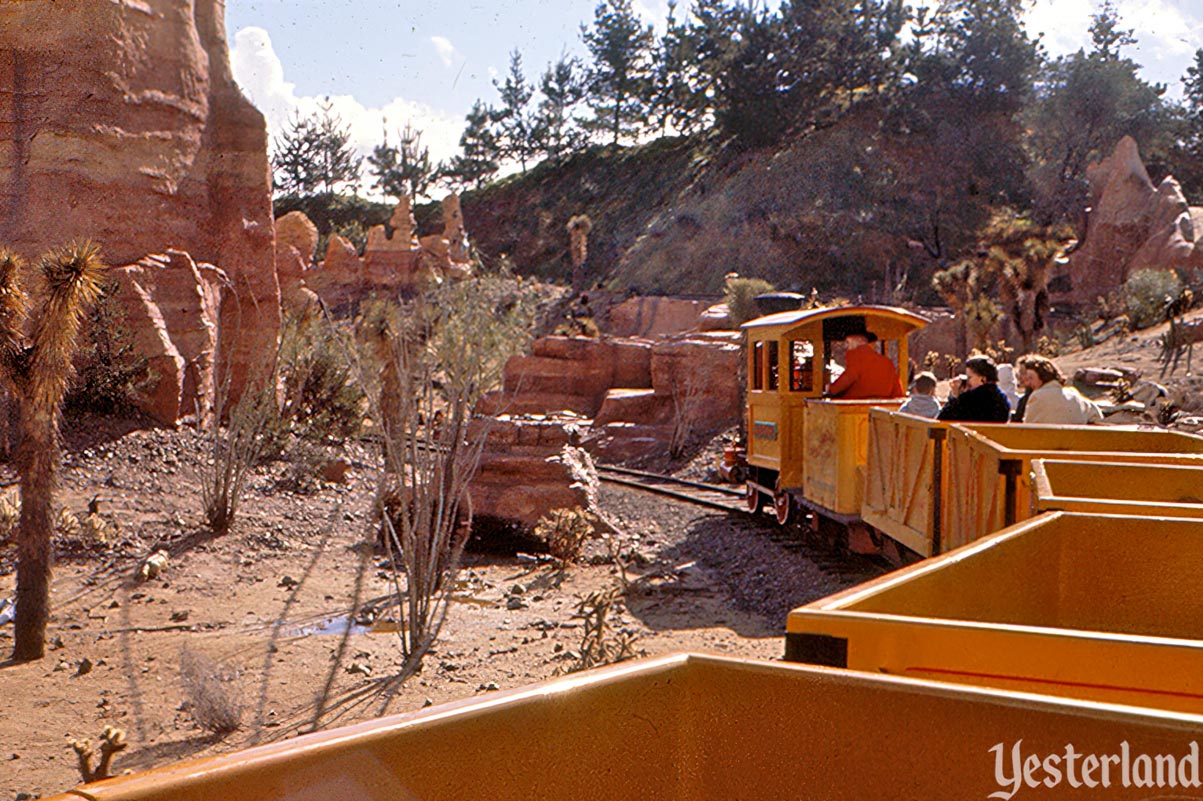
Photo by Roger J. Runck, 1961, courtesy of Robin Runck The Living Desert |
|||
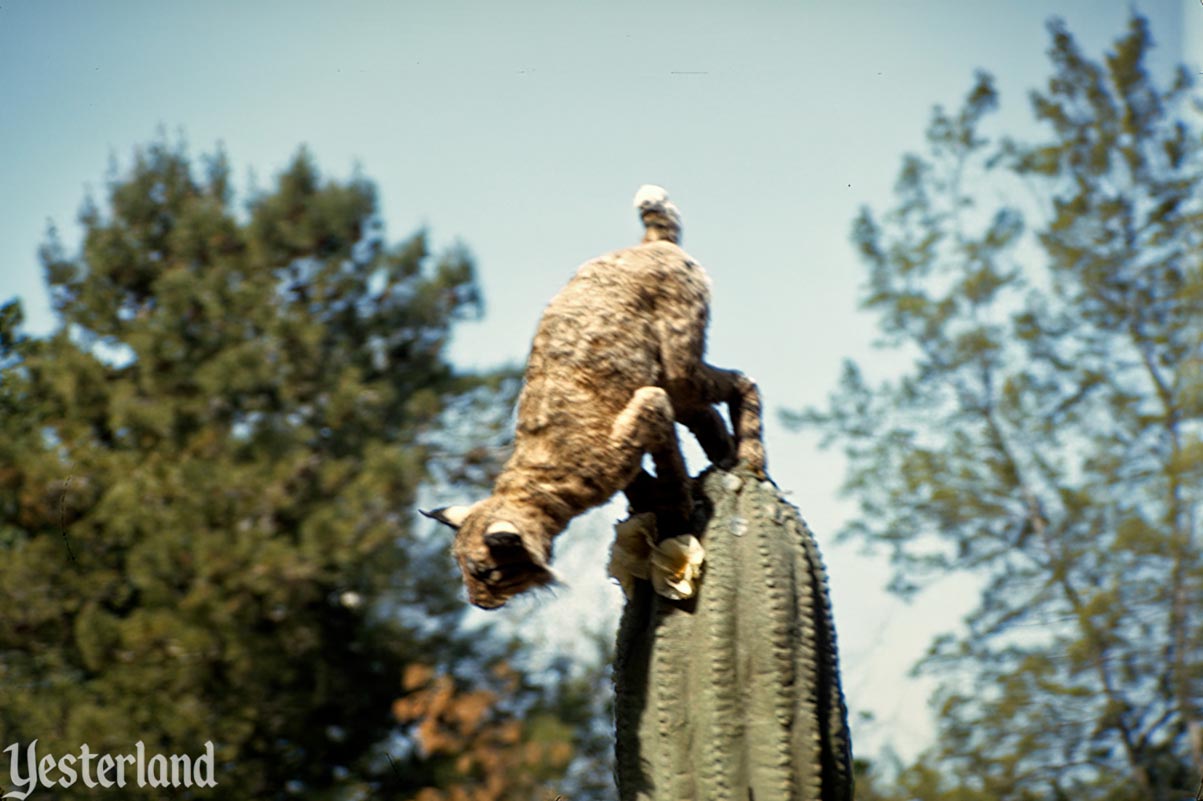
Photo by Dennis Caswell, 1975 Ol’ Mister Bobcat |
|||
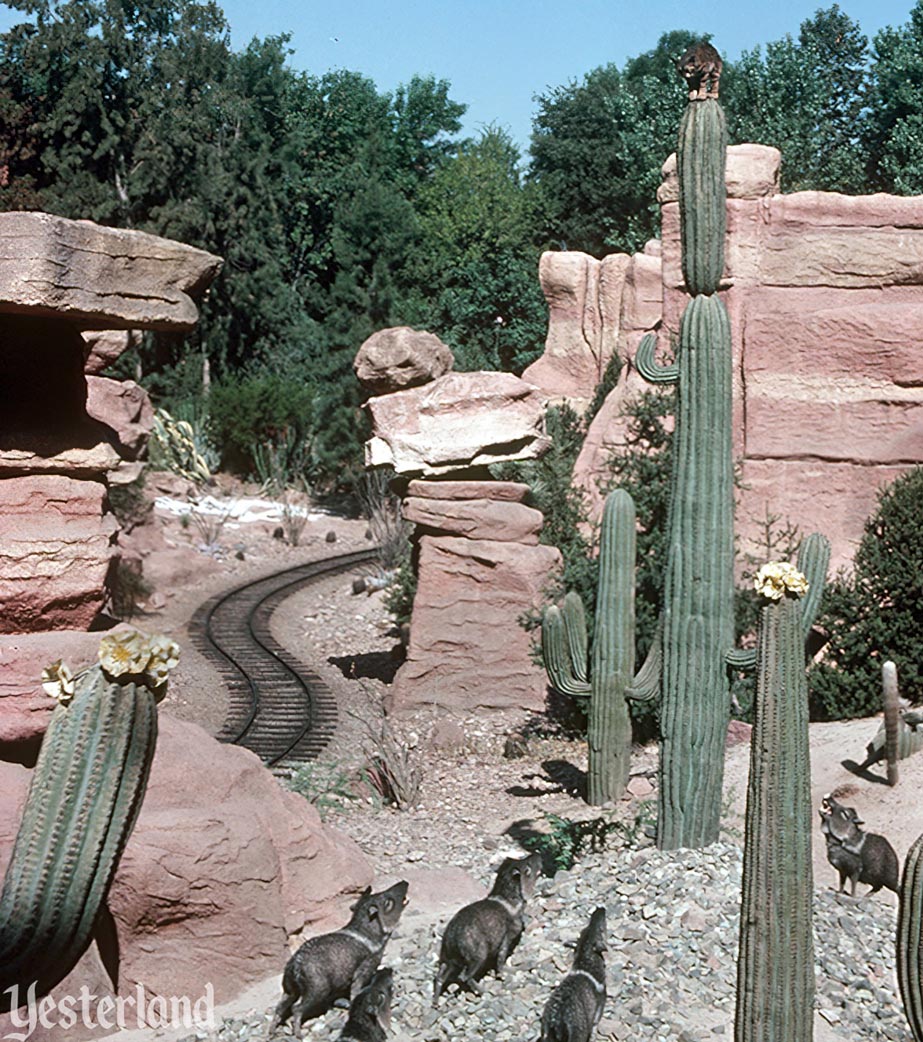
Photo by Marion Caswell, 1976, courtesy Dennis Caswell Wild pigs |
|||
|
“Aha! Look down there on yer left. Them wild pigs has caught up with ol’ Mister Bobcat. He’s in kind of a sticky situation! |
|||
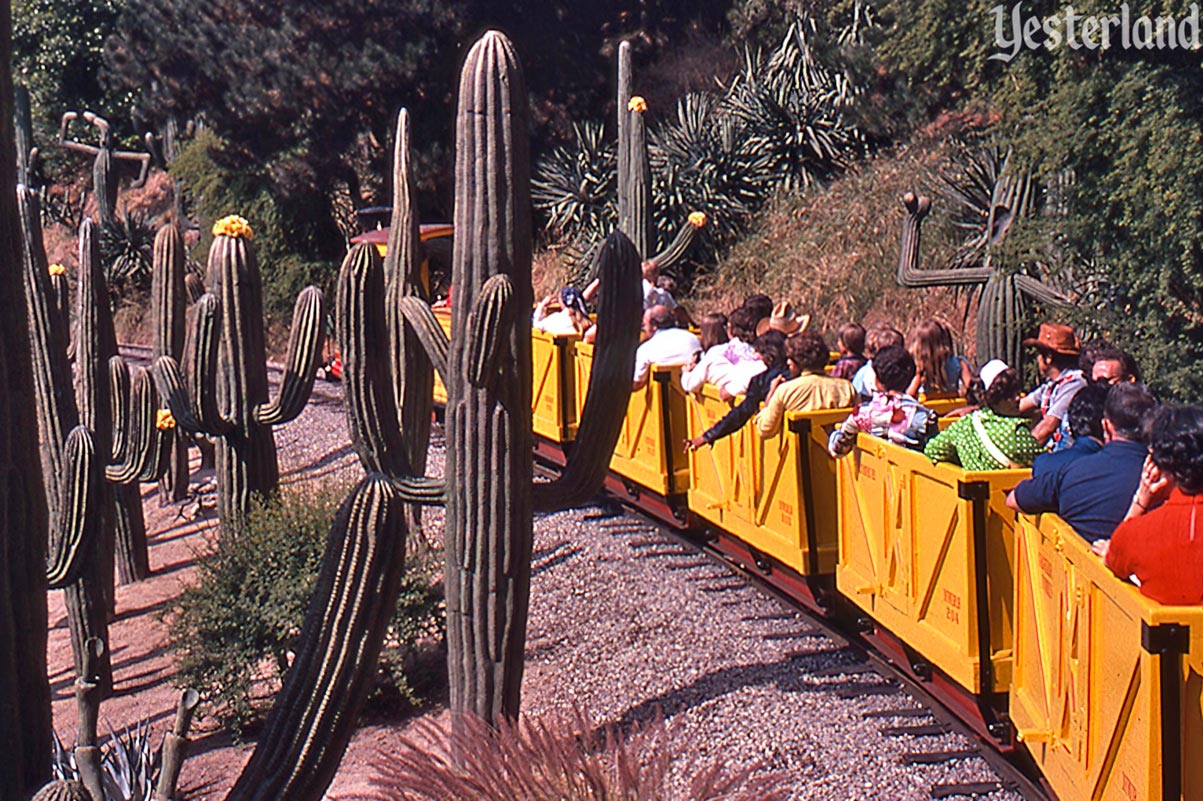
Photo by Werner Weiss, 1975 Saguaro forest |
|||
|
“Now ahead of us, folks, is a giant saguaro cactus forest. The desert heat sometimes gets to ya and makes these here cactus take on strange shapes, like animals… and sometimes even people. |
|||
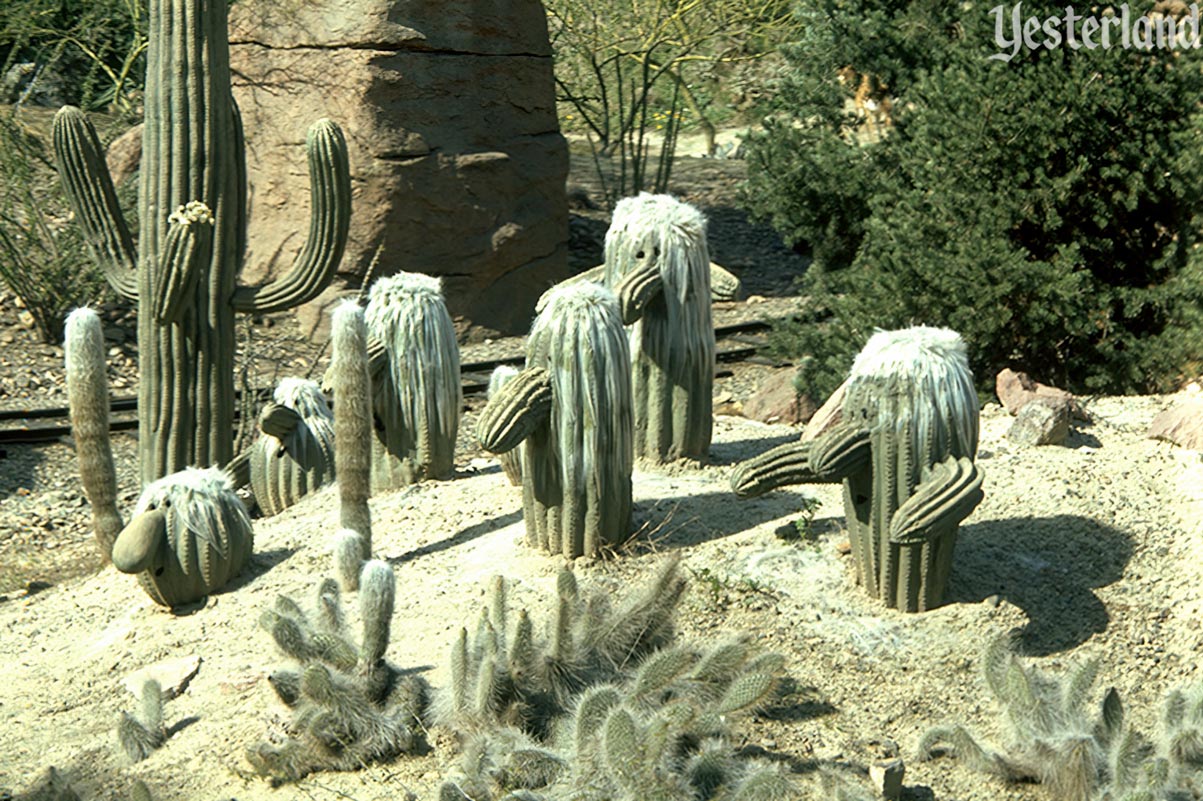
Photo by Dennis Caswell, 1975 Yes, even people |
|||
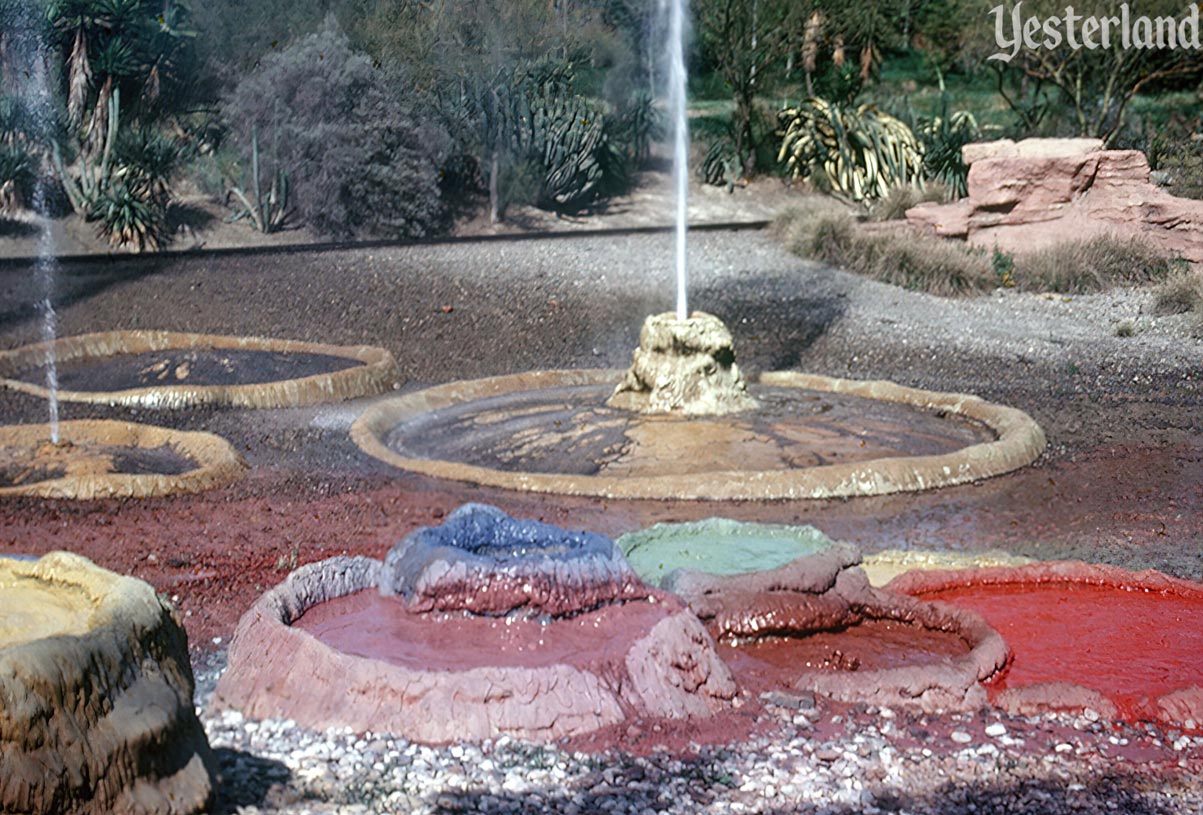
Photo by Marion Caswell, 1975, courtesy Dennis Caswell Devil’s Paint Pots, “bubblin’ pots o’ mud” |
|||
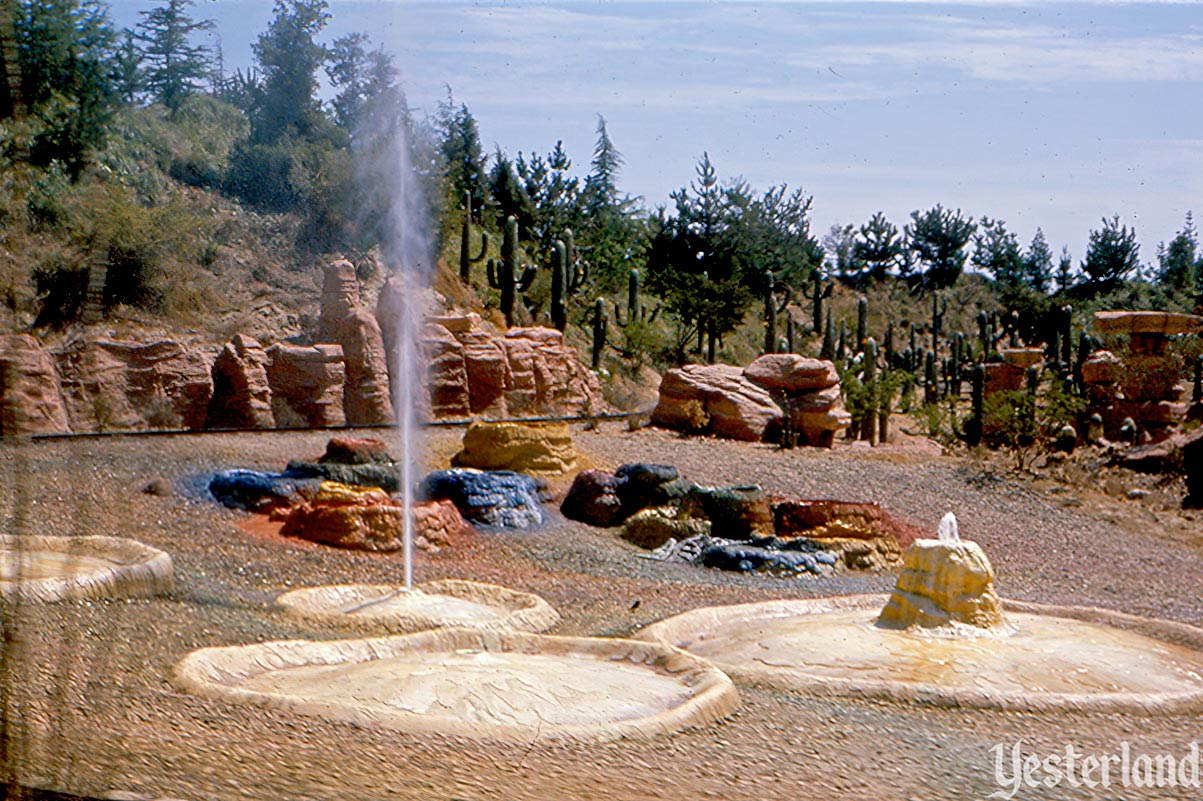
Photo by Roger J. Runck, 1969, courtesy of Robin Runck Geyser Country too |
|||
|
“Say… ever hear of the Devil’s Paint Pots? Real mystery of the desert. Bubblin’ pots o’ mud in all kinds o’ colors. This is Geyser Country too. Uh-oh, there she blows! Sure glad ya all brought yer raincoats. But look out now! We never know when she’s gonna go off. That’s why we call her Ol’ Unfaithful. Look out now! Heh-heh! You folks in them last cars be ready… she’s a-threatenin’ again! |
|||
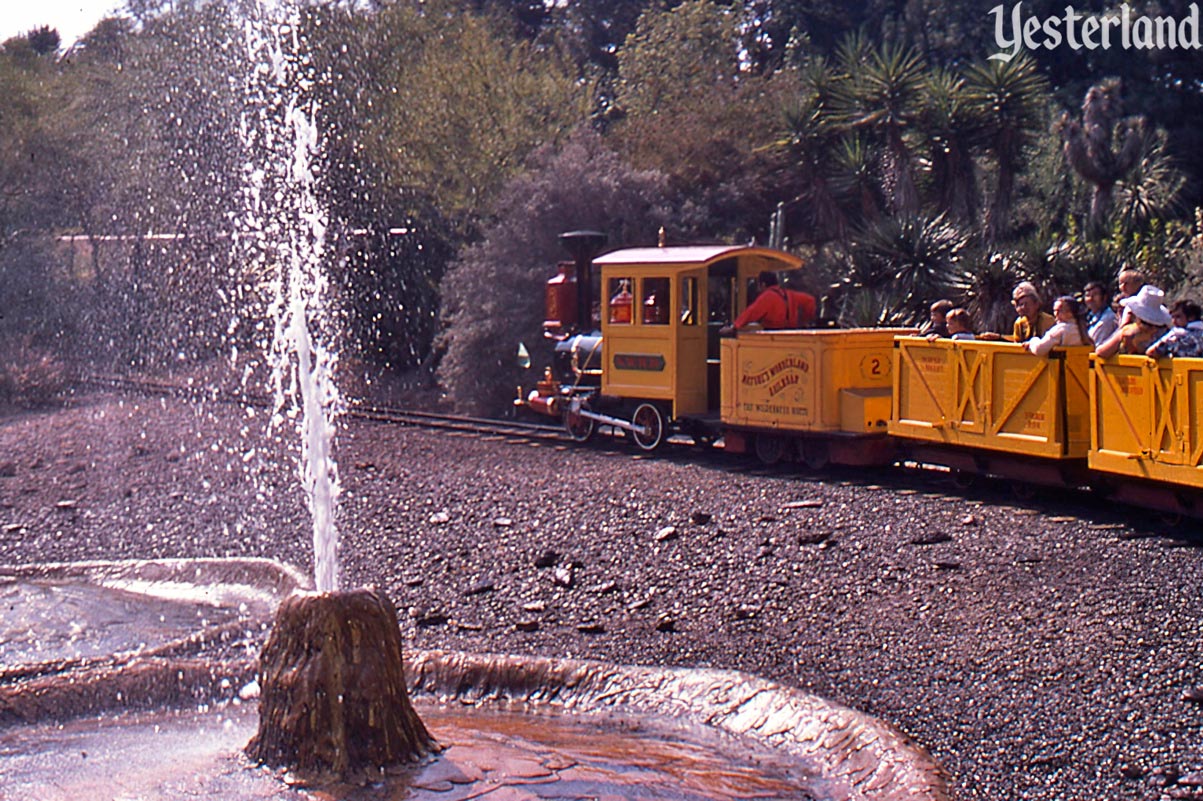
Photo by Werner Weiss, 1975 Ol’ Unfaithful |
|||
|
“Ya know, I hear tell a long time ago, dinosaurs roamed this area. Of course, all you find now is cactus, snakes and coyotes—and sometimes the sun-bleached bones of an ancient animal. “There’s the voice of the desert—the coyote. |
|||
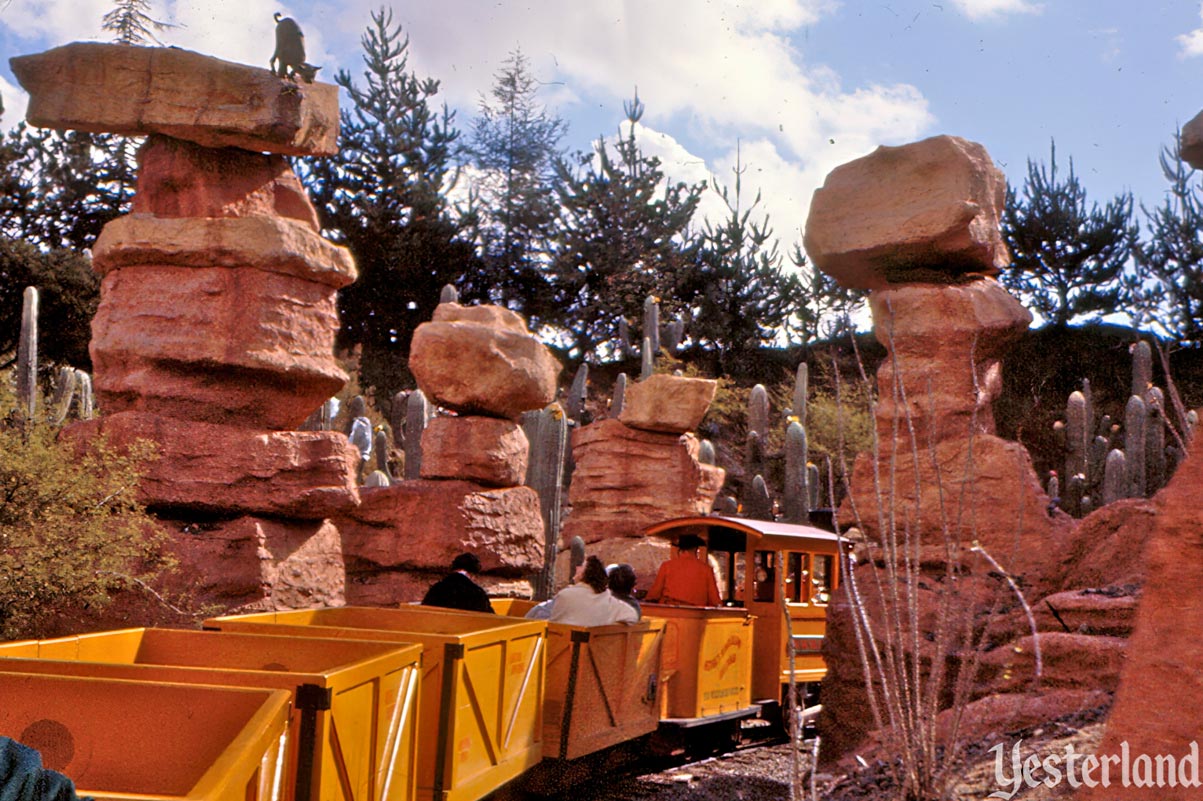
Photo by Roger J. Runck, 1961, courtesy of Robin Runck Balancing Rocks |
|||
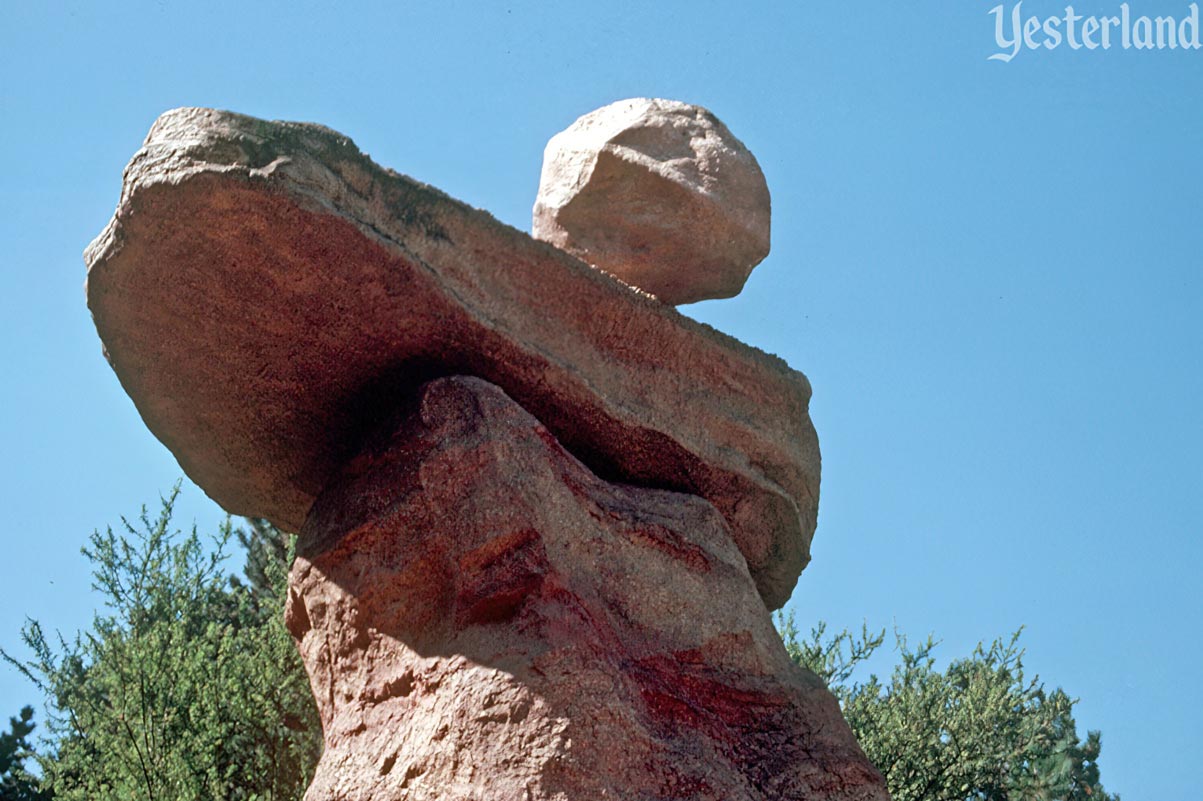
Photo by Marion Caswell, 1976, courtesy Dennis Caswell Startin’ to tumble! |
|||
|
“Now folks, we gotta get through balancing rock canyon. Look out! They’re startin’ to tumble! Watch that wildcat, lady! Oooh! Heh, heh! Glad he stayed up there! We’ve known these critters to take on a full-growed deer more’n ten times their size and weight. “You know, last trip, a mountain lion showed up right over that tunnel. There’s one now, so you better all be real quiet! |
|||
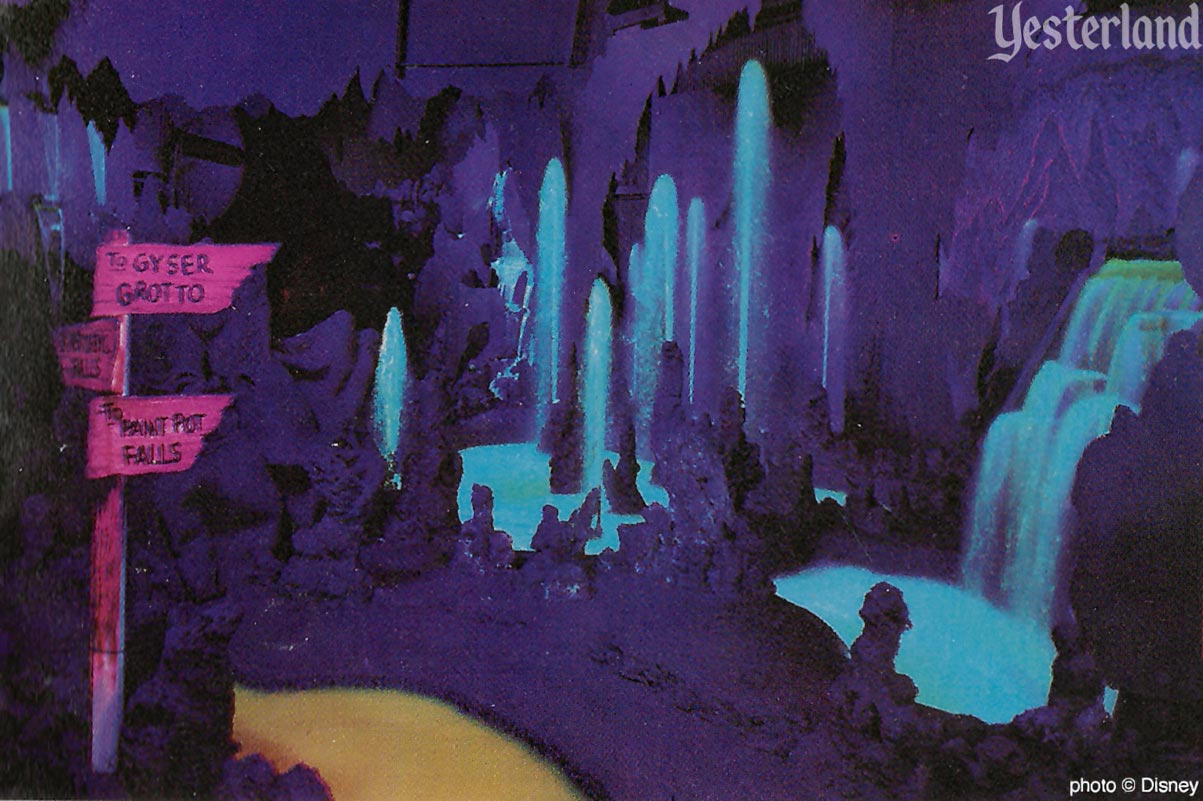
From Walt Disney’s Guide to Disneyland, 1961 © Disney Inside Rainbow Caverns |
|||
|
“Now, we’re goin’ deep into the earth to view the dazzling Rainbow Caverns. You’ll see giant stalagmites, stalactites, ‘n colorful falls on ever’ side. Say, if ya look real careful, you’ll see geyser grotto, ‘n even the witch’s cauldron. |
|||
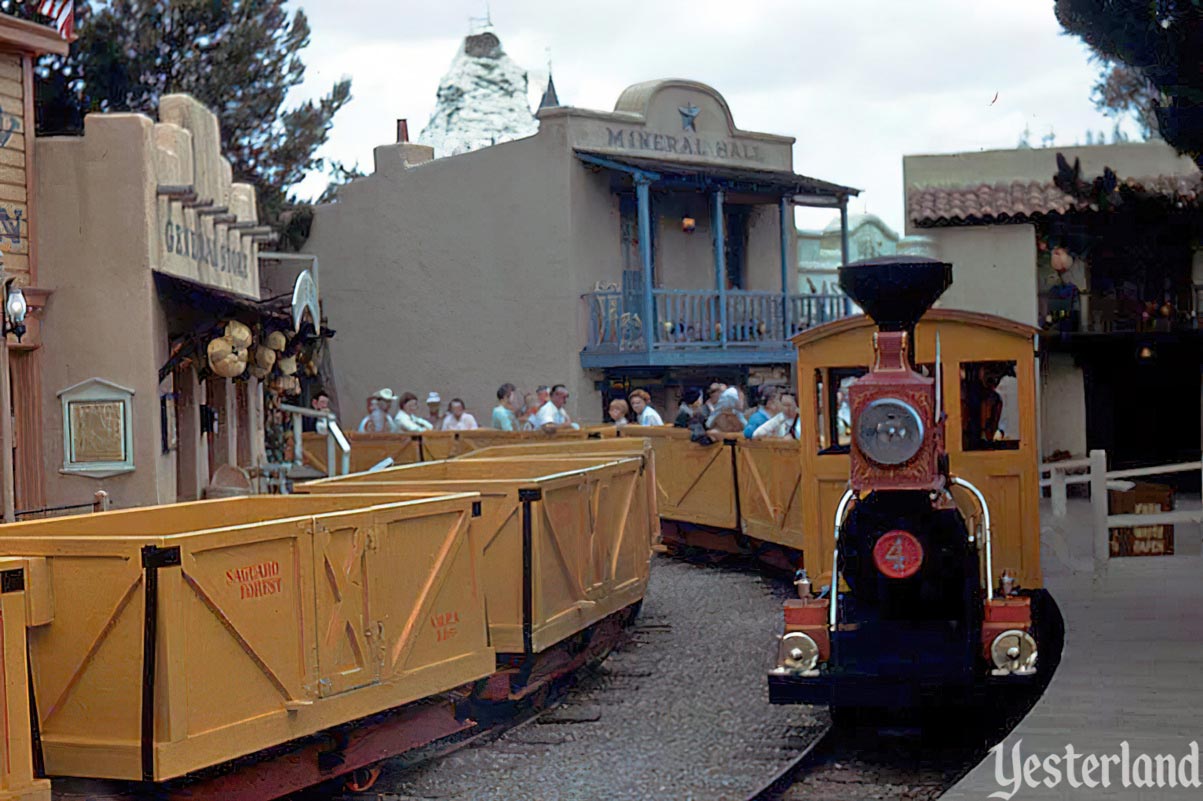
Photo by cpo57, (CC BY 2.0) (modified) Returning to Rainbow Ridge |
|||
|
“Well, I see we’re comin’ back to Rainbow Ridge again. I hope you all enjoyed yer trip into Nature’s Wonderland. Please stay in yer seats until I get the train stopped, will ya? And then just lift up the jump seat in the middle, and the door’ll come right open.” |
|||
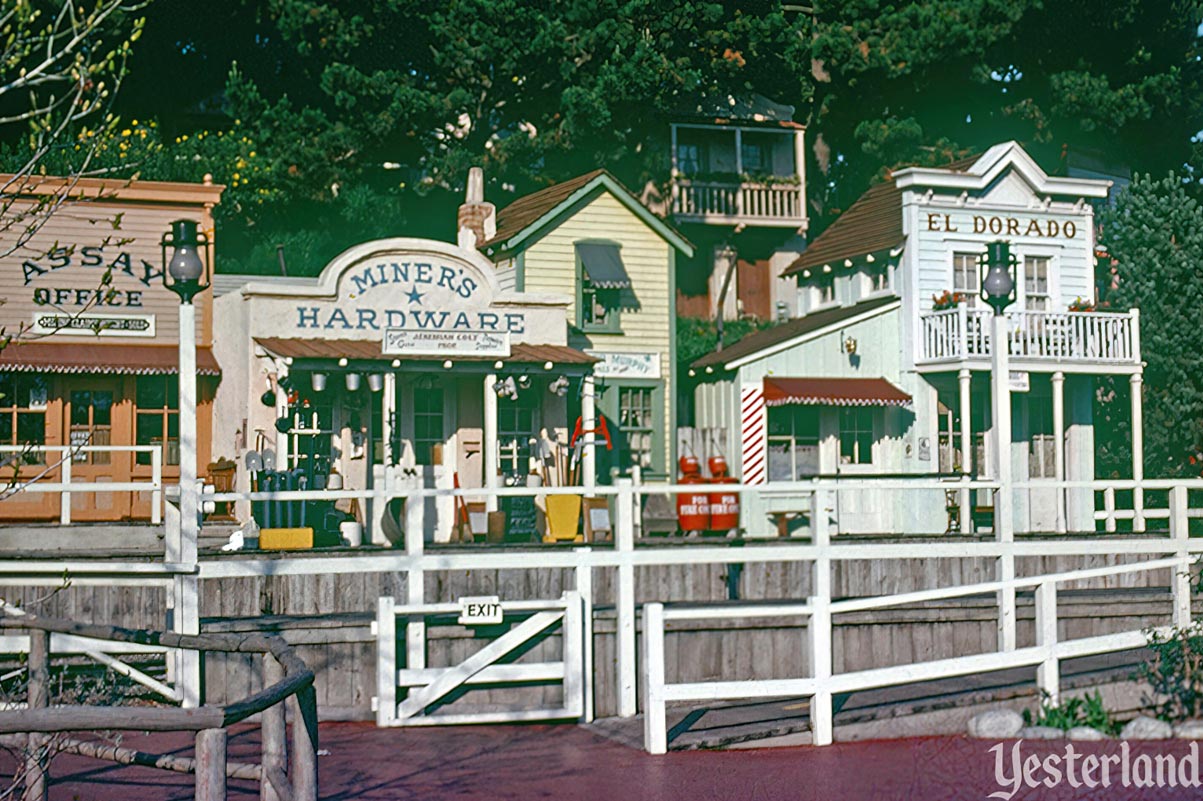
Photo by Marion Caswell, 1975, courtesy Dennis Caswell Exit at Rainbow Ridge |
|||
|
“Now, to find the exit, folks, just head right for the front of the train. And if ya got a mountain lion sittin’ next to ya, don’t feed him. Just tell him to hop out and hightail it back to his own stompin’ ground. Well, thanks for ridin’ along, and come on back when yer out here in these here frontier parts, will ya? So long!” Here’s a secret that not many people know. If you board the Mine Train around 8:50 p.m., the train will stop on a hillside above the Living Desert. You’ll be treated to the best view of the fireworks anywhere in the park. Each pyrotechnic burst in the sky illuminates the otherwise almost-dark Living Desert. No crowds. And no noise, except for sound effects from the Living Desert and the explosions in the sky. |
|||
|
|
|||
|
The Mine Train Through Nature’s Wonderland opened in Disneyland in 1960 as an expansion of the Rainbow Caverns Mine Ride (1956). On June 12, 1960, Walt Disney hosted an old-fashioned picnic to show off the new attraction to 700 press representatives, their families, and other invited guests. A Los Angeles Times article (“Mechanical Animals, Visitors Frolic in Disney’s New Nature Wonderland” by Richard West, June 13, 1960) described the event. Here’s an excerpt from it: [Walt] Disney and his three cowboy-hatted grandchildren were the official hosts at the all-day ceremonies. Tammy Miller, 3, her sister, Joanna, 5, and their brother, Chris, 5, and Disney wielding tiny hatchets, cut through a sapling to open the animated beaver set. The beavers slapped the water with their tails, dived and bobbed to the surface. Then the youngsters, children of Ron and Diane Disney Miller, boarded the Western Mine Train with their grandfather to see all the animated animals in Nature’s Wonderland in action. They saw black bears diving for fish in a mountain stream, deer frolicking on a hilltop, tusked boars sniffing the air, howling coyotes, hooting owls, cawing crows, and a mountain lion with lighted eyes peer out from a dark cave. Most electrifying to youngsters may be a big mountain cat climbing a tree to get at a nest of baby hawks. Mother hawk was on guard, however, with her sharp beak and talons, ready to drive him off. Other highlights of the journey were Rainbow Caverns, with multi-colored waterfalls and music, and Cascade Peak, 75-ft. high mountain with three waterfalls plunging into Frontierland River. In all, there are 204 animated animals in their natural habitat in Nature’s Wonderland, situated on a seven-acre site in Frontierland. They may be viewed either from the Western Mine Train or from pack mules. Nature’s Wonderland was built at a cost of $1.8 million. It is Disneyland’s 45th attraction. The Mine Train Through Nature’s Wonderland operated until January 2, 1977. In its final years, the attraction had been demoted from an “E” ticket to a “D” ticket. The time had come to replace the venerable mine train with a different kind of mine train. |
|||
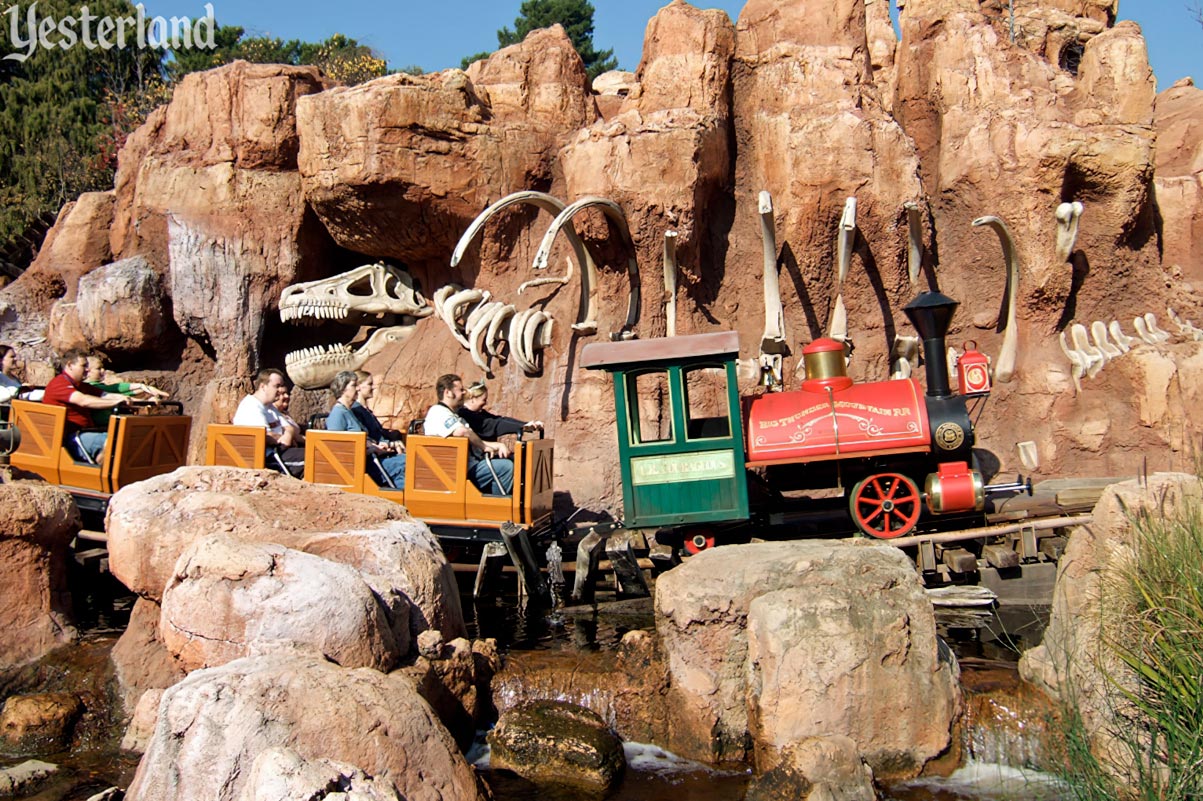
Photo by Allen Huffman, 2005 Much faster than the old Mine Train |
|||
|
Big Thunder Mountain Railroad, a thrill ride themed as a mine train, opened in 1979. |
|||
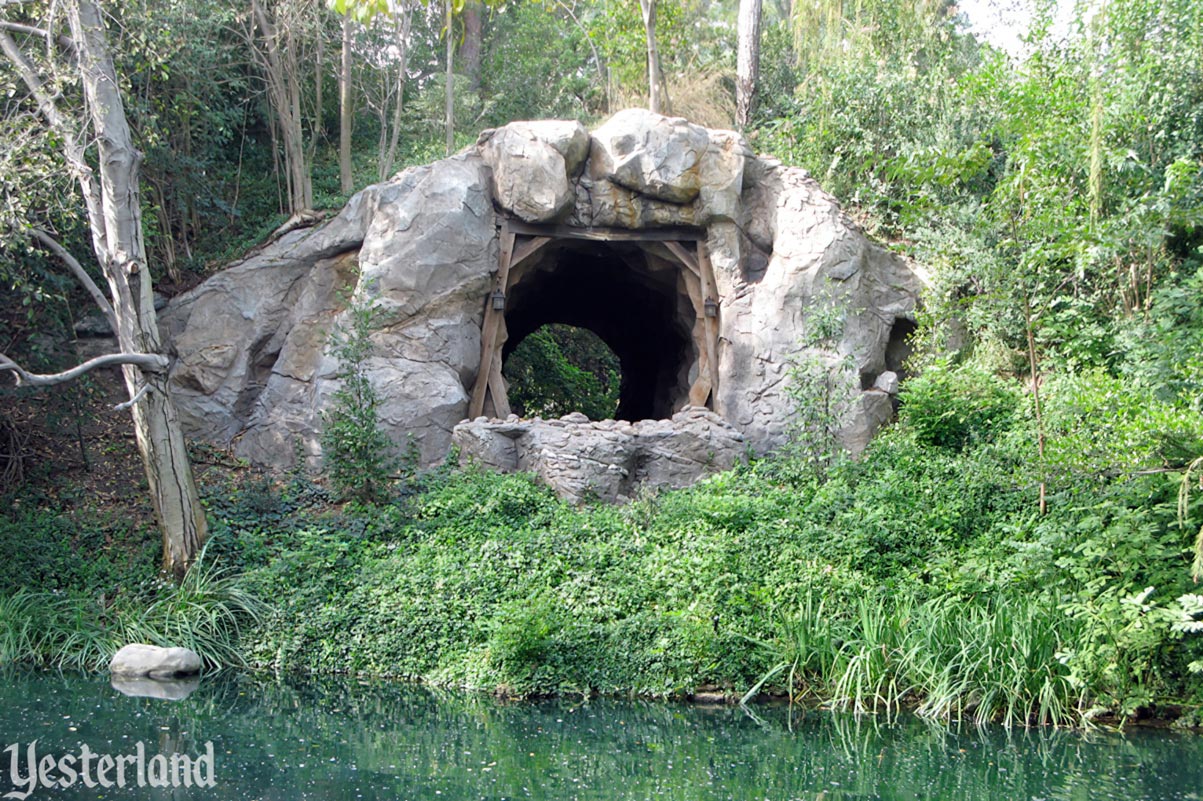
Photo by Werner Weiss, 2007 Across the former Beaver Valley pond, as it looked in 2007 |
|||
|
But not all is gone. And as you walk along the trail across from Big Thunder Mountain Railroad towards the paths to Star Wars: Galaxy’s Edge, you’re walking through what’s left of Beaver Valley. Look across the pond for an old Mine Train tunnel. |
|||
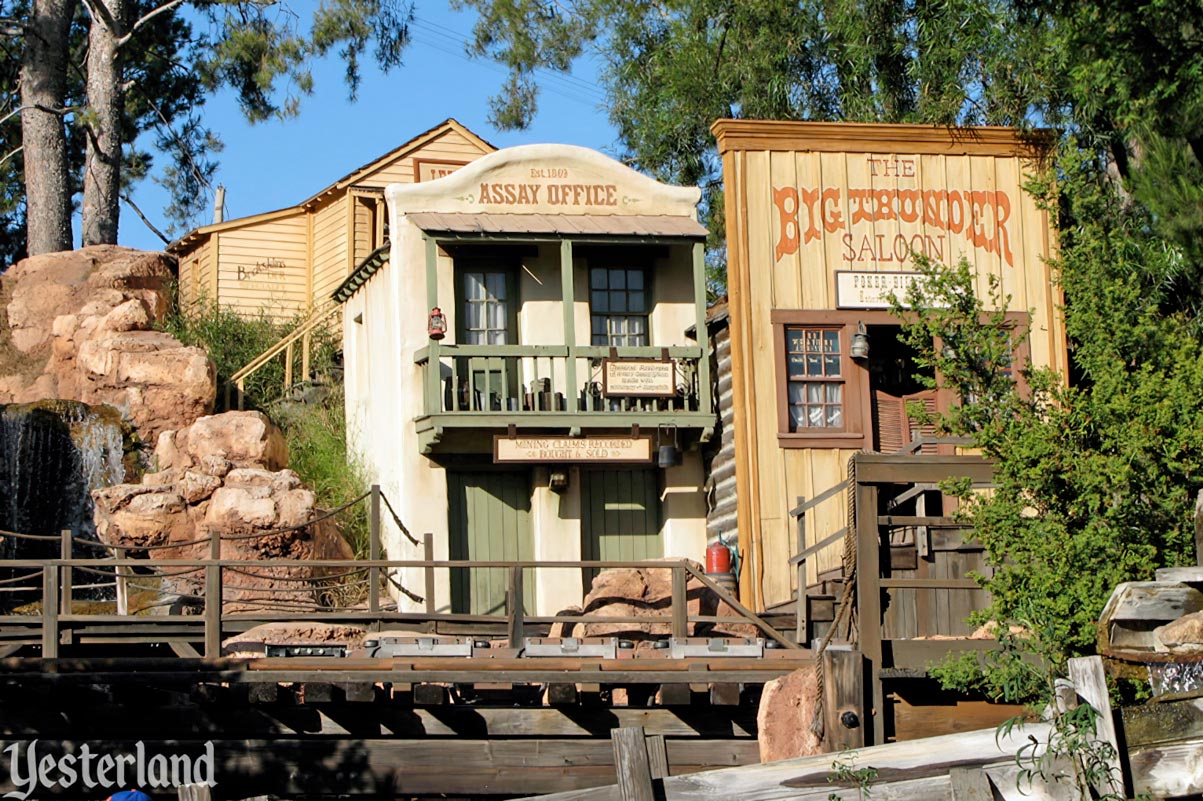
Photo by Werner Weiss, 2007 Rainbow Ridge, long after the demise of the Mine Train |
|||
|
Parts of Rainbow Ridge survived the transition to a thrill ride. Buildings from the little town still grace the hills above the waiting area for Big Thunder Mountain Railroad. |
|||
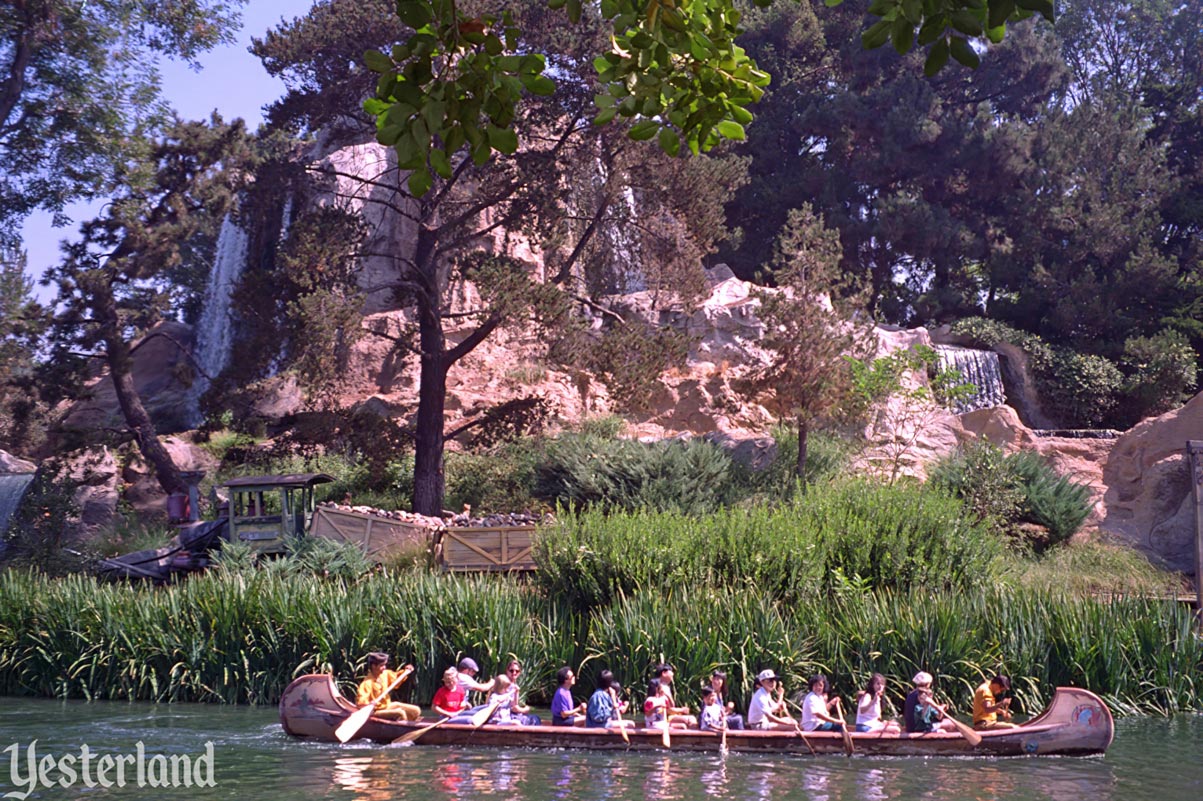
Photo by Werner Weiss, 1996 Davy Crockett’s Explorer Canoes and Cascade Peak in 1996 |
|||
|
The biggest part of the Mine Train ride to survive the demolition of the old ride was Cascade Peak, a rugged mountain with several large waterfalls. Back in 1960, Cascade Peak was surrounded by little trees, giving the appearance of a mountain rising majestically above a forest. As the trees grew taller over several decades, Cascade Peak appeared to become smaller and smaller. The actual height of the peak didn’t change, but our perception of its height was changed by the relative scale of the trees and the peak. Until the end of Summer 1998, the waterfalls of Cascade Peak continued to roar into the Rivers of America. Before the end of 1998, Cascade Peak was completely gone. Years of water damage had taken their toll on the man-made peak’s structural integrity. The problem was solved with a bulldozer. |
|||
|
|
Click here to post comments at MiceChat about this article.
© 1997-2020 Werner Weiss — Disclaimers, Copyright, and Trademarks Updated March 29, 2020. Mine Train narration based on transcript by Dennis Caswell. |
||